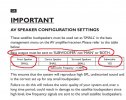Which is fine, but does mean we're a bit limited for non-freestanding speakers. They're being tested with a protocol that was never intended for them.
Headphones would also score abysmally on a speaker spinorama and freestanding response, but we've got a different scientifically backed target curve and measurement method for them.
Wall-mounted (on or in) speakers are clearly a different beast to freestanding, even though far less than headphones are, and using the standard "predicted in-room response" calculations that assume a wall some distance behind just aren't going to produce accurate results.
I don't think there's anything much else we could do for measurements at this point, but we could certainly look at what target curve we're aiming at, and an actual on-wall listening test would be a small step to getting there. Floyd chapter 9 suggests that for something flush with the wall you're looking for something with a shelf in its response around 500Hz. This speaker has something like that, but gets penalised for it because we're looking for something with flat response. And because it's not being listened to on-wall, we're not finding out whether that shelf was the right thing to do for the wall mount or not.
 Thank you Amir for another revealing, objective test. Hopefully, it will save people $650USD. Maybe they'll be listed on Woot in a few months for $125.
Thank you Amir for another revealing, objective test. Hopefully, it will save people $650USD. Maybe they'll be listed on Woot in a few months for $125. 
 Thank you Amir for another revealing, objective test. Hopefully, it will save people $650USD. Maybe they'll be listed on Woot in a few months for $125.
Thank you Amir for another revealing, objective test. Hopefully, it will save people $650USD. Maybe they'll be listed on Woot in a few months for $125. 
